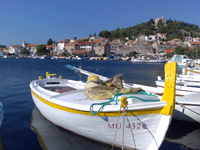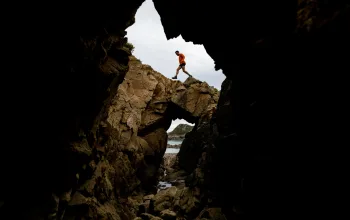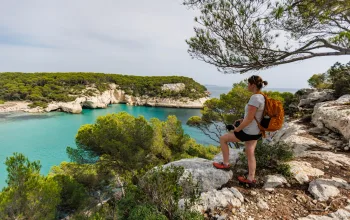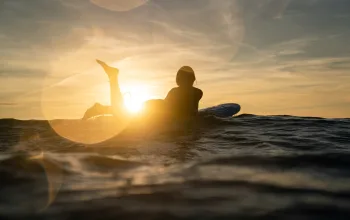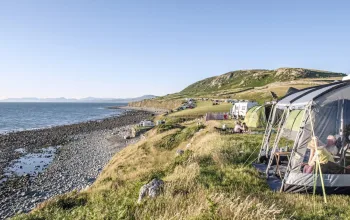Croatia Calling!
‘If you fail to prepare, then prepare to fail,’ our skipper, Jim, was saying as we were getting our 36-foot yacht, Stella, ready to leave harbour. Right on cue, our neighbour attempted to depart her berth, with the water and electrics still connected to the quayside, causing considerable amusement all round and proving Jim’s point in an instant.
We are on a learn-to-sail week at Murter Island on Croatia’s Adriatic coast. We are 1,600km from the 50km gap that links the Mediterranean to the Atlantic which is far enough away that we don’t have to deal with any tides. Also, there are more than 1,000 islands just off mainline Croatia, giving ample opportunity to find shelter if the winds develop into storms. This has to be the ideal place to ‘learn the ropes’.
Stella is capable of sleeping eight but is much more comfortable with six, with one forward cabin and two aft (rear) and the option to sleep in a pull-down bed in the lounge. The crew this week are a very diverse bunch. Jim is from Dublin, Russell and Donna are from New Zealand, although latterly SW19, Paul and Laura are midway through a European tour and home is Anchorage, Alaska. My South London roots are feeling distinctly unexotic.
We are introduced to the ‘head’ (nautical talk for toilet) and advised that if we cause a blockage then we will be responsible for sorting the problem – yuk! Safety advice on using cooker, location and use of fire equipment, and radio, are very important at sea and received our full attention. Briefing over, and it is time to make sure all the hatches are fastened and doors properly closed before we set off. The first morning is spent manoeuvring under power near our berth and feeling the effects even a slight wind can have on our boat.
We can’t wait to leave harbour, of course, and before long the sails are hoisted for the first time. There’s a lot to learn here and we all struggle to come to terms with our new language, ‘yachting’. Jim has been at sea for 25 years, which, considering he is only 27, is quite an achievement. We learn how to use the winches, clutches, sheets, halyards, and topping lines (an assortment of ropes and pulley systems). The difference between a granny knot and a reef knot is etched on my memory, and a dozen others too. After a few days, reefing the mainsail (reducing its size) becomes almost second nature and trimming the jib sail for extra speed proves extremely satisfying.
The week developed into a pattern of sailing between lunch and overnight stops. Four yachts from Activity Yachting were out that week, three on learn-to-sail and one made up of three guys with previous experience. We would go our own way during the day, sometimes meeting up for lunch but always getting together at the evening rendezvous. These alternated between marina with hot showers, to small islands with a single jetty and restaurant. This is the beauty of yachting for me – a different venue every night, and constantly changing scenery.
Our second day saw us heading to the small island of Kaprije. Mooring proved a challenge as the wind was up, but we had a recommended restaurant, Antonio’s, to look forward to. There are no cars on the island and telephone numbers are hard to find, so Jim had to hoof it to the other side of the island to check that Antonio’s was open. It wasn’t – but the owner was happy to open on hearing of some potential guests. The only caveat was that there would be no menu – we would simply eat what he cooked. A little apprehensively, we made our way there and sat down to proper Croatian dining. Starters were Dalmatian ham and a roasted pepper, next up was a black squid risotto, and main course was a platter of tuna steaks, shark and conger eel with polenta. The meal turned out to be very good value, beautifully cooked, and washed down with buckets of local wine. We were offered a terrifying home-made spirit by our hosts to see us on our way home.
The next day, a brisk wind helped us along on route to Tribunj. We managed to get the toe rail in the water a few times, which in landlubber terms meant the mast was at an angle of around 45 degrees to the water – pretty exciting for us novices, as it felt you are only one gust away from a capsize.
Continued...
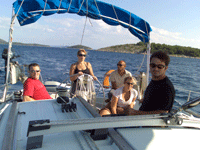 What a beautiful place. The old town of Tribunj is an island only 135m across, and linked to the mainland by a small bridge. A wonderful mix of stone houses and the occasional bar on a waterfront setting made for a beautiful stroll, before a dinner of Hungarian goulash. There are still some buildings in a dilapidated state waiting for a sympathetic restoration, but they only add to the character of the place. This is exactly what you would hope to find in Croatia. A rustic church at the top of a small hill – easily walkable – and the modern marina sits very well within the scene.
What a beautiful place. The old town of Tribunj is an island only 135m across, and linked to the mainland by a small bridge. A wonderful mix of stone houses and the occasional bar on a waterfront setting made for a beautiful stroll, before a dinner of Hungarian goulash. There are still some buildings in a dilapidated state waiting for a sympathetic restoration, but they only add to the character of the place. This is exactly what you would hope to find in Croatia. A rustic church at the top of a small hill – easily walkable – and the modern marina sits very well within the scene.
The winds were lighter in the second part of the week with plenty of time to practise man-overboard procedures. Not too difficult under engine power in light winds, but recovering someone with sails hoisted and a stiff breeze was a very different experience. ‘Wilson’ (our buoy dressed as a man overboard) was suffering from our lack of talent.
We were surprised to find that the yacht went faster into the wind than downwind. The sails are just like an aeroplane wing and the pressure difference between the two sides produce some serious lift when tacking into the wind. Another unexpected sailing phenomenon was being able to see the wind – well, the effects of wind anyway. The water would change colour to a darker blue, and you could therefore see when a gust was about to hit the yacht, and trim the sails accordingly. All very groundbreaking stuff for a non-yachtie.
Further overnight stops at Jezera and Ziminjak, and gorgeous lunchtime halts such as Luka bay and Vrgada (good for snorkelling), saw the week continue in the same fabulous vein. The end of the week saw our final stop back in Betina Marina. Each of us had achieved our International Competent Crew certificate and more than a few vowed to return to complete a Day Skipper or Flotilla Skipper certificate. Never had learning something new been so rewarding.
Getting there
Flights to Split or Zadar are typically available through BA, Easyjet, Croatia Airlines, Thomas Cook, Wizzair.
Activity
Activity Yachting (www.activityyachting.com) operates from Murter Island, Croatia, and Greece.
Activity Yachting offer family holidays, including and Ashore & Afloat option
More info
For the Croatian Tourist Board, visit www.croatia.hr


